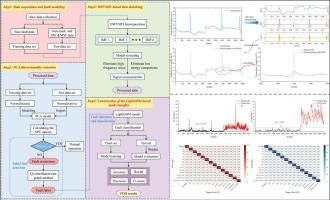A fault detection and diagnosis method based on DWVMD-PCA-LightGBM for multi-sensor faults at VAV terminals in office areas of industrial buildings
IF 7.1
2区 工程技术
Q1 CONSTRUCTION & BUILDING TECHNOLOGY
引用次数: 0
Abstract
In variable air volume (VAV) air-conditioning systems, sensor faults can cause control strategy failures, leading to increased energy consumption and reduced operational efficiency. To enable effective detection and classification of sensor faults, this study proposes a novel fault detection approach that integrates signal denoising, feature extraction, and fault classification. The method first employs an improved dynamic weighted variational mode decomposition (DWVMD) to denoise the raw sensor signals, effectively suppressing the interference of measurement noise during model training. Subsequently, principal component analysis (PCA) is used to reduce the dimensionality of the extracted multivariate feature vectors and perform initial fault detection. Finally, based on the PCA-transformed features and their corresponding labeled fault types, a light gradient boosting machine (LightGBM) classifier is trained to accurately identify both single-source fault (SSF) and multi-source fault (MSF). The study is based on real operational data from the VAV system in the office area of an industrial building, covering 7 types of SSFs and 6 types of MSFs. Comparative analysis was performed against five other diagnostic methods. The results indicate that the proposed DWVMD-PCA-LightGBM method demonstrates strong robustness and high accuracy in sensor fault detection, achieving diagnostic accuracies between 93.8% and 100%, with a false alarm rate (FAR) of only 0.07% and a fault detection rate (FDR) of 99.13%. Compared with the five benchmark methods, the proposed approach consistently delivers superior performance under complex operating conditions.

基于DWVMD-PCA-LightGBM的工业建筑办公变风量终端多传感器故障检测与诊断方法
在变风量(VAV)空调系统中,传感器故障会导致控制策略失效,从而导致能耗增加和运行效率降低。为了有效地检测和分类传感器故障,本研究提出了一种集成信号去噪、特征提取和故障分类的新型故障检测方法。该方法首先采用改进的动态加权变分模态分解(DWVMD)对原始传感器信号进行降噪,有效抑制了模型训练过程中测量噪声的干扰。随后,利用主成分分析(PCA)对提取的多变量特征向量进行降维,进行初始故障检测。最后,基于pca变换后的特征及其相应的标记故障类型,训练光梯度增强机(LightGBM)分类器来准确识别单源故障(SSF)和多源故障(MSF)。本研究基于某工业建筑办公区域变风量系统的实际运行数据,涵盖7种ssf和6种msf。与其他五种诊断方法进行比较分析。结果表明,所提出的DWVMD-PCA-LightGBM方法在传感器故障检测中具有较强的鲁棒性和较高的准确率,诊断准确率在93.8% ~ 100%之间,虚警率(FAR)仅为0.07%,故障检测率(FDR)为99.13%。与五种基准方法相比,该方法在复杂工况下始终具有优越的性能。
本文章由计算机程序翻译,如有差异,请以英文原文为准。
求助全文
约1分钟内获得全文
求助全文
来源期刊

Energy and Buildings
工程技术-工程:土木
CiteScore
12.70
自引率
11.90%
发文量
863
审稿时长
38 days
期刊介绍:
An international journal devoted to investigations of energy use and efficiency in buildings
Energy and Buildings is an international journal publishing articles with explicit links to energy use in buildings. The aim is to present new research results, and new proven practice aimed at reducing the energy needs of a building and improving indoor environment quality.
 求助内容:
求助内容: 应助结果提醒方式:
应助结果提醒方式:


